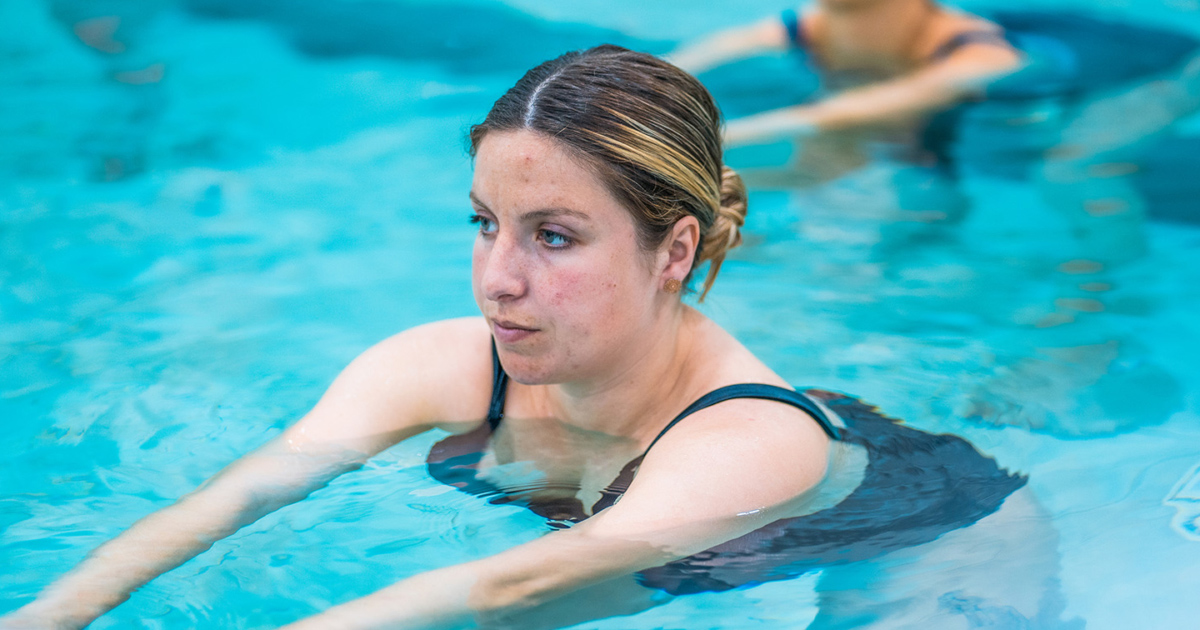Benefits of Aquanatal for Pregnant Women
Celebrating her 7th year at Revive Physiotherapy & Aquatic Centre, senior physiotherapist Francesca Bonnici continues to help many women with their pre-and post-natal care. With a wealth of experience in the field of childbearing, including exposure to a range of birthing experiences through her highly experienced midwife mother, Francesca discusses the crucial role of staying active and healthy during pregnancy.
Pregnancy is a beautiful and exciting time in a woman’s life, but it can also be a challenging and uncomfortable experience. Many women experience musculoskeletal problems, such as back pain, pelvic pain, and swelling during pregnancy. And while it may be tempting to limit movement and take it easy during this time, the truth is that staying active is incredibly important for both the mother and the baby.
Contrary to what some people may believe, exercise during pregnancy is not only safe but also recommended by healthcare professionals. Regular physical activity can help reduce the risk of complications such as pre-eclampsia. It can also improve mood, energy levels, and sleep quality, and is also crucial in preparing the mother’s body for childbirth.
If you were not active before pregnancy, don’t worry, it’s never too late to start. Implementing movement into your routine can help minimise pain in several problematic areas. There are many different types of exercise that are safe and effective during pregnancy, including aquanatal exercises.
Aquanatal exercise is a type of exercise that is carried out in a hydrotherapy pool with a set temperature of 34.6 degree Celsius, where the warm water and its properties are especially well-suited for pregnant women. The warm water helps relax the muscles and improve flexibility, which can be especially beneficial for women experiencing back pain or pelvic pain. Hydrotherapy aids in decreasing swelling in the limbs, and promote relaxation which is what an expectant mother truly needs.
In addition to aquanatal exercise, there are many other types of exercise that are safe and effective during pregnancy, including walking, swimming, yoga, and Pilates. However, it is important to consult with your gynae or physiotherapist before starting any new exercise routine, especially if you were not active before pregnancy.
If you are looking to choose between attending regular gym sessions or aquanatal sessions, consider scheduling a one-to-one consultation with a professional to go over your physical history and determine the ideal way forward. If you are used to working out regularly and can carry added weight well, land-based exercise may be more suitable for you. However, if you do not have a regular exercise routine, walking for a minimum of 30 minutes per day can be a great starting point to improve your physical fitness.
Remember, it’s better to commit to some movement on a regular basis rather than nothing at all. Regular physical activity during pregnancy can reduce the risk of complications during labour and after labour.
Carrying out some form of exercise will help your body endurance and also targeting and focusing on strengthening your pelvic floor and core muscle will help then provide you faster healing post-natal.
It is also important to know when to stop or reduce the intensity of exercise. By the 38th week of pregnancy, it is recommended to reduce the intensity of exercise and focus on exercises that will help the mother’s pelvis prepare for childbirth. While exercise will not speed up the pregnancy toward the end of term, it can help ease the way through the delivery day.
When thinking about exercise during pregnancy, it may be helpful to view the delivery day as the finish line in a race. All efforts are to arrive at this point physically and mentally healthy and ready for the next phase of this beautiful journey. After delivery, the goal of your exercise regimen should be for all your muscles to return to prior conditioning, flexibility, and strength.
With all that in mind, here are five quick tips to keep in mind to help you stay active and healthy during and after your pregnancy:
#1 – Always consult with your gynae, physiotherapist or midwife before starting or continuing an exercise routine during pregnancy. They can help you determine what types of exercise are safe for you and your baby based on your individual health and pregnancy.
#2 – Devote at least one hour per week to yourself, as it’s easy to forget your needs once the baby arrives. Regular exercise can help you feel more energised and better prepared for childbirth and postpartum recovery.
#3 – Stay hydrated and avoid getting overheated by exercising in a well-ventilated environment. This is especially important during the later stages of pregnancy when you may be more prone to overheating.
#4 – Listen to your body and adjust your exercise routine as your pregnancy progresses. As your body changes and your baby grows, certain exercises may become uncomfortable or difficult to perform. Be mindful of your limitations and modify your routine as needed.
#5 – After giving birth, it’s important to get a pelvic floor assessment from a physiotherapist. They can help you determine the status of your recovery and guide you on when it’s safe to gradually return to exercise.
To learn more about aquanatal and pre-natal and post-natal fitness solutions at Revive Physiotherapy & Aquatic Centre tailored to pregnant women, please get in touch by calling on 2235 1000. We look forward to hearing from you and helping you on your pregnancy journey.
